battery Ram 3500 2014 Diesel Supplement
[x] Cancel search | Manufacturer: RAM, Model Year: 2014, Model line: 3500, Model: Ram 3500 2014Pages: 360, PDF Size: 2.02 MB
Page 15 of 360

How To Use Remote Start
All of the following conditions must be met before the
engine will remote start:
РђбShift lever in PARK
РђбDoors closed
РђбHood closed
РђбHAZARD switch off
РђбBRAKE switch inactive (brake pedal not pressed)
РђбBattery at an acceptable charge level
РђбRKE PANIC button not pressed
РђбFuel meets minimum requirement
РђбWater In Fuel Indicator Light is not illuminated
РђбРђюWait To StartРђЮ telltale is not illuminated
WARNING!
РђбDo not start or run an engine in a closed garage or
confined area. Exhaust gas contains Carbon Mon-
oxide (CO) which is odorless and colorless. Carbon
Monoxide is poisonous and can cause serious in-
jury or death when inhaled.
РђбKeep Remote Keyless Entry (RKE) transmitters
away from children. Operation of the Remote Start
System, windows, door locks or other controls
could cause serious injury or death.
2
THINGS TO KNOW BEFORE STARTING YOUR VEHICLE 13
Page 33 of 360
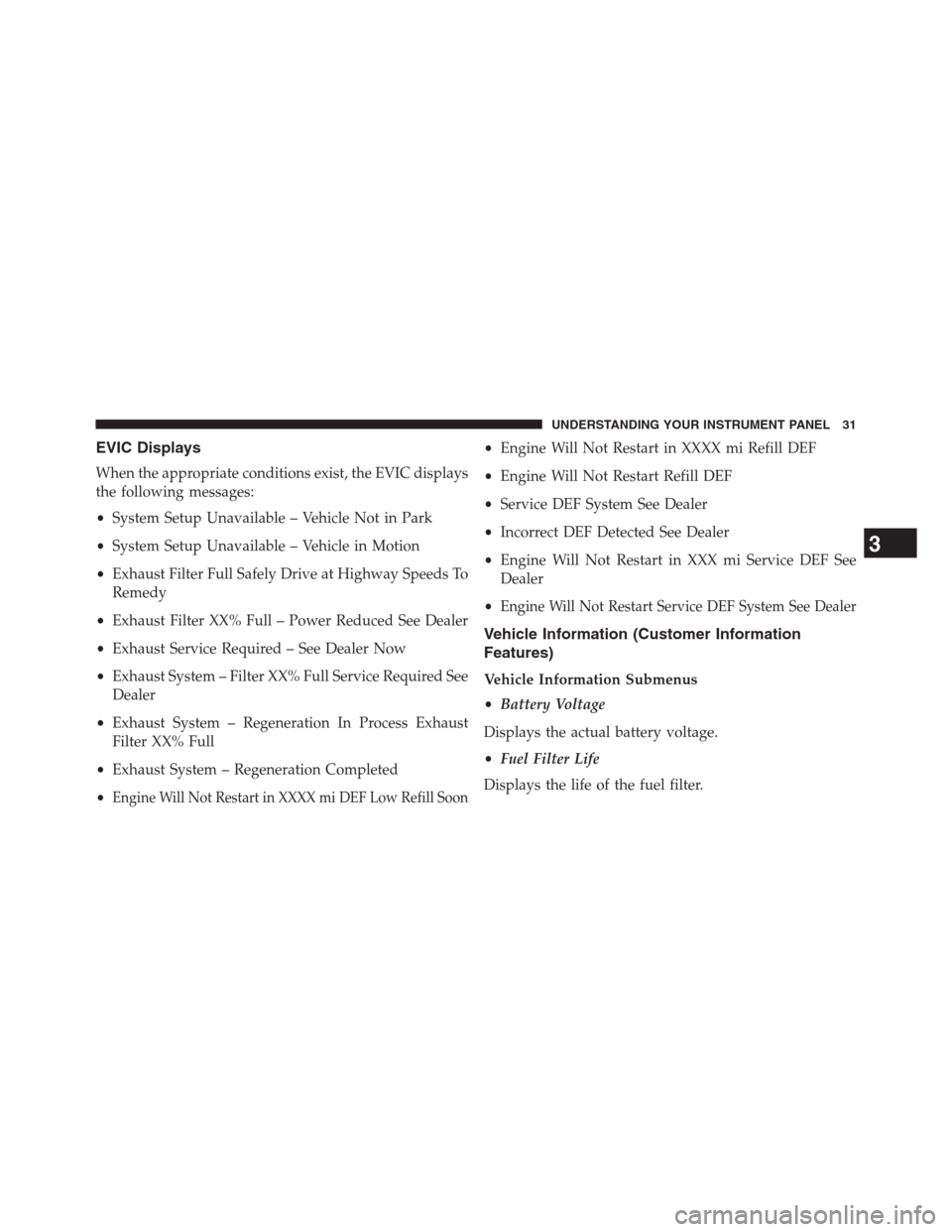
EVIC Displays
When the appropriate conditions exist, the EVIC displays
the following messages:
РђбSystem Setup Unavailable РђЊ Vehicle Not in Park
РђбSystem Setup Unavailable РђЊ Vehicle in Motion
РђбExhaust Filter Full Safely Drive at Highway Speeds To
Remedy
РђбExhaust Filter XX% Full РђЊ Power Reduced See Dealer
РђбExhaust Service Required РђЊ See Dealer Now
РђбExhaust System РђЊ Filter XX% Full Service Required See
Dealer
РђбExhaust System РђЊ Regeneration In Process Exhaust
Filter XX% Full
РђбExhaust System РђЊ Regeneration Completed
Рђб
Engine Will Not Restart in XXXX mi DEF Low Refill Soon
РђбEngine Will Not Restart in XXXX mi Refill DEF
РђбEngine Will Not Restart Refill DEF
РђбService DEF System See Dealer
РђбIncorrect DEF Detected See Dealer
РђбEngine Will Not Restart in XXX mi Service DEF See
Dealer
Рђб
Engine Will Not Restart Service DEF System See Dealer
Vehicle Information (Customer Information
Features)
Vehicle Information Submenus
РђбBattery Voltage
Displays the actual battery voltage.
РђбFuel Filter Life
Displays the life of the fuel filter.
3
UNDERSTANDING YOUR INSTRUMENT PANEL 31
Page 90 of 360

Four-Pin Connector
1 Рђћ Female Pins 4 Рђћ Park
2 Рђћ Male Pin 5 Рђћ Left Stop/Turn
3 Рђћ Ground 6 Рђћ Right Stop/Turn
Seven-Pin Connector
1 Рђћ Battery 5 Рђћ Ground
2 Рђћ Backup Lamps 6 Рђћ Left Stop/Turn
3 Рђћ Right Stop/Turn 7 Рђћ Running Lamps
4 Рђћ Electric Brakes 88 STARTING AND OPERATING
Page 102 of 360

ENGINE COMPARTMENT Рђћ 3.0L DIESEL
1 Рђћ Air Cleaner Filter 5 Рђћ Battery
2 Рђћ Engine Oil Dipstick 6 Рђћ Power Distribution Center (PDC)
3 Рђћ Engine Oil Fill 7 Рђћ Washer Fluid Reservoir
4 Рђћ Brake Fluid Reservoir 8 Рђћ Engine Coolant 100 MAINTAINING YOUR VEHICLE
Page 113 of 360
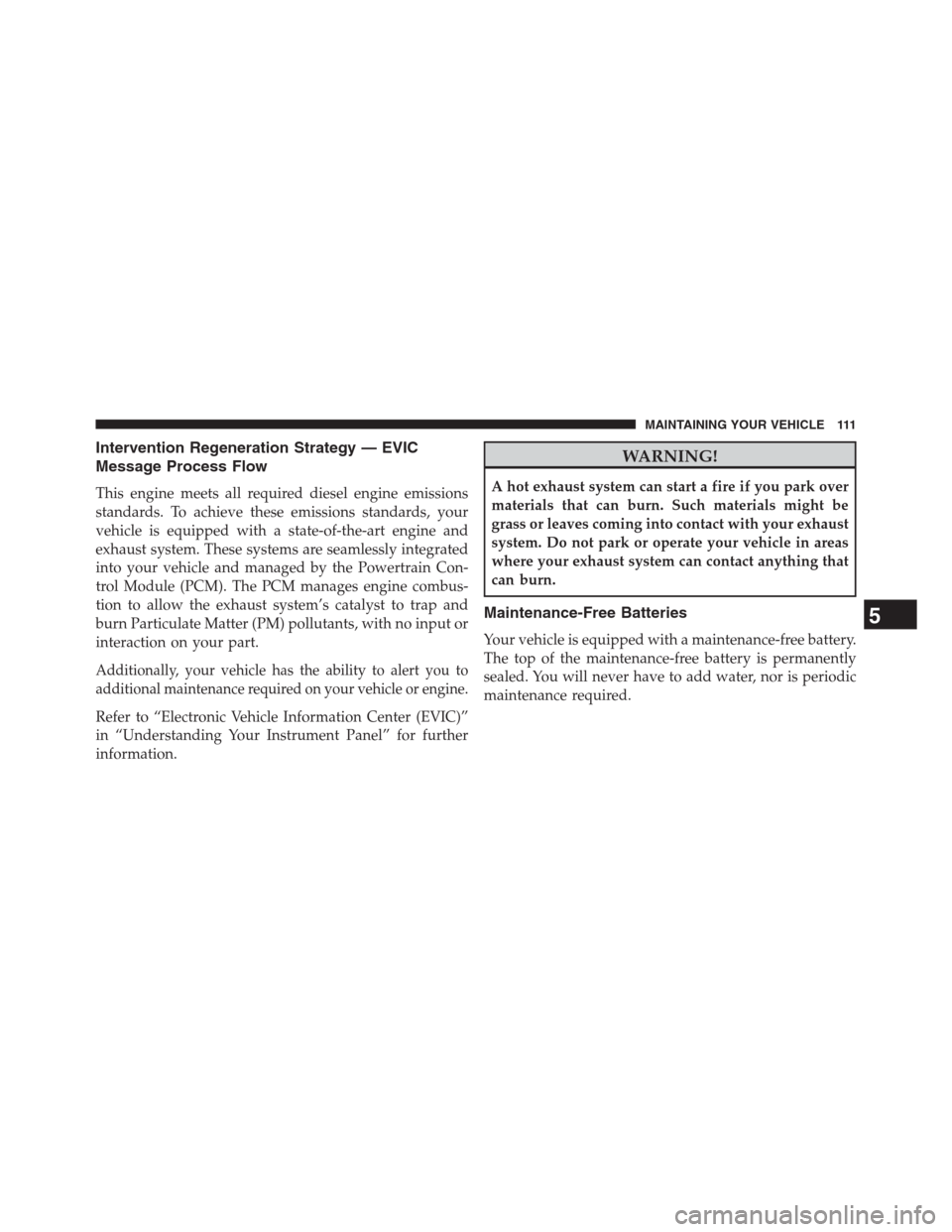
Intervention Regeneration Strategy Рђћ EVIC
Message Process Flow
This engine meets all required diesel engine emissions
standards. To achieve these emissions standards, your
vehicle is equipped with a state-of-the-art engine and
exhaust system. These systems are seamlessly integrated
into your vehicle and managed by the Powertrain Con-
trol Module (PCM). The PCM manages engine combus-
tion to allow the exhaust systemРђЎs catalyst to trap and
burn Particulate Matter (PM) pollutants, with no input or
interaction on your part.
Additionally, your vehicle has the ability to alert you to
additional maintenance required on your vehicle or engine.
Refer to РђюElectronic Vehicle Information Center (EVIC)РђЮ
in РђюUnderstanding Your Instrument PanelРђЮ for further
information.
WARNING!
A hot exhaust system can start a fire if you park over
materials that can burn. Such materials might be
grass or leaves coming into contact with your exhaust
system. Do not park or operate your vehicle in areas
where your exhaust system can contact anything that
can burn.
Maintenance-Free Batteries
Your vehicle is equipped with a maintenance-free battery.
The top of the maintenance-free battery is permanently
sealed. You will never have to add water, nor is periodic
maintenance required.
5
MAINTAINING YOUR VEHICLE 111
Page 114 of 360

CAUTION!
It is essential when replacing the cables on the
battery that the positive cable is attached to the
positive post and the negative cable is attached to the
negative post. Battery posts are marked (+) positive
and negative (-) and are identified on the battery
case. Also, if a Рђюfast chargerРђЮ is used while the battery
is in vehicle, disconnect both vehicle battery cables
before connecting the charger to the battery. Do not
use a Рђюfast chargerРђЮ to provide starting voltage.
WARNING!
Battery posts, terminals, and related accessories con-
tain lead and lead compounds. Always wash hands
after handling the battery.
Cooling System
WARNING!
You or others can be badly burned by hot engine
coolant (antifreeze) or steam from your radiator. If
you see or hear steam coming from under the hood,
do not open the hood until the radiator has had time
to cool. Never try to open a cooling system pressure
cap when the radiator is hot.
Engine Coolant Checks
Check the engine coolant (antifreeze) protection every 12
months (before the onset of freezing weather, where
applicable). If the engine coolant (antifreeze) is dirty or
rusty in appearance, the system should be drained,
flushed and refilled with fresh coolant. Check the front of
the A/C condenser (if equipped) or radiator for any
accumulation of bugs, leaves, etc. If dirty, clean by gently
112 MAINTAINING YOUR VEHICLE
Page 131 of 360
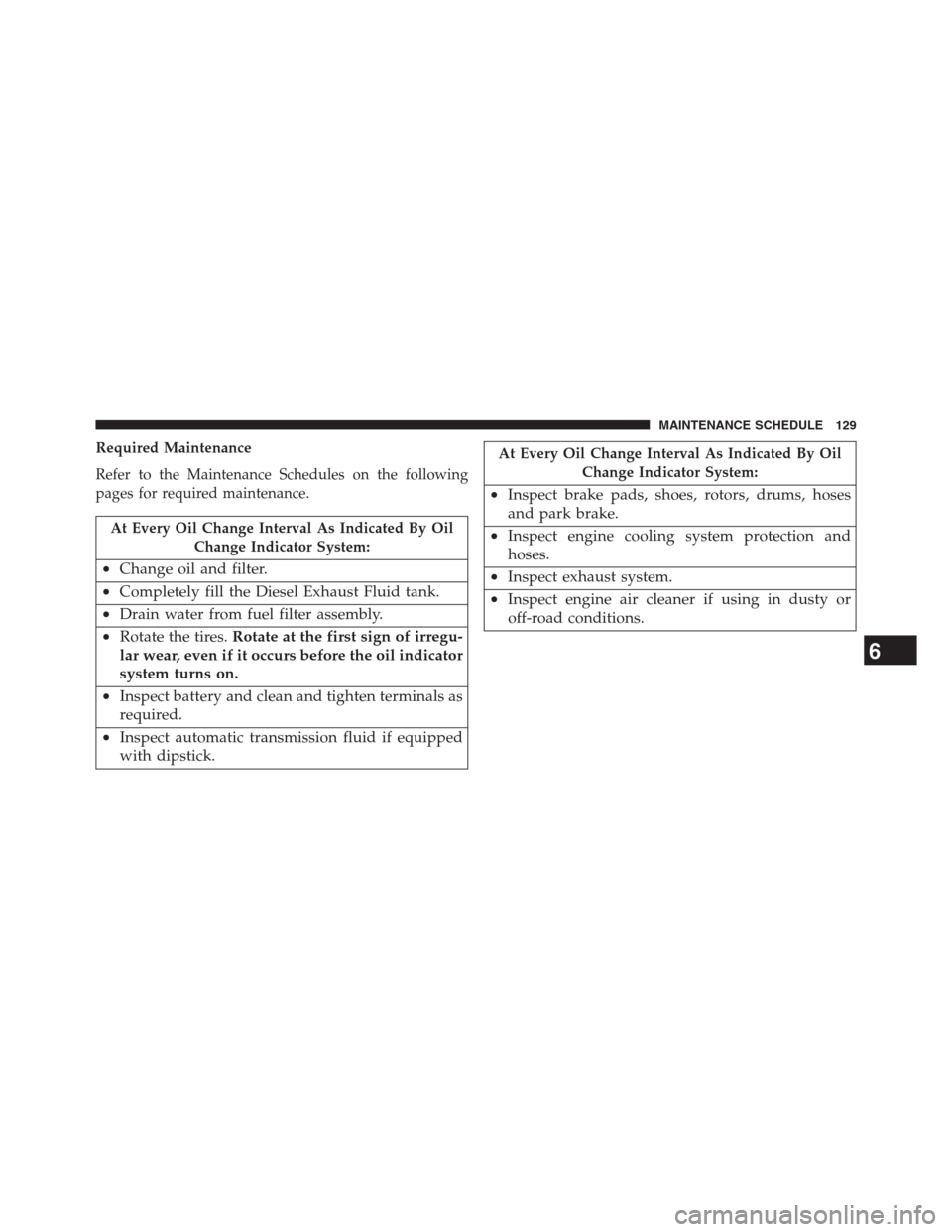
Required Maintenance
Refer to the Maintenance Schedules on the following
pages for required maintenance.
At Every Oil Change Interval As Indicated By Oil
Change Indicator System:
РђбChange oil and filter.
РђбCompletely fill the Diesel Exhaust Fluid tank.
РђбDrain water from fuel filter assembly.
РђбRotate the tires.Rotate at the first sign of irregu-
lar wear, even if it occurs before the oil indicator
system turns on.
РђбInspect battery and clean and tighten terminals as
required.
РђбInspect automatic transmission fluid if equipped
with dipstick.
At Every Oil Change Interval As Indicated By Oil
Change Indicator System:
РђбInspect brake pads, shoes, rotors, drums, hoses
and park brake.
РђбInspect engine cooling system protection and
hoses.
РђбInspect exhaust system.
РђбInspect engine air cleaner if using in dusty or
off-road conditions.
6
MAINTENANCE SCHEDULE 129
Page 148 of 360
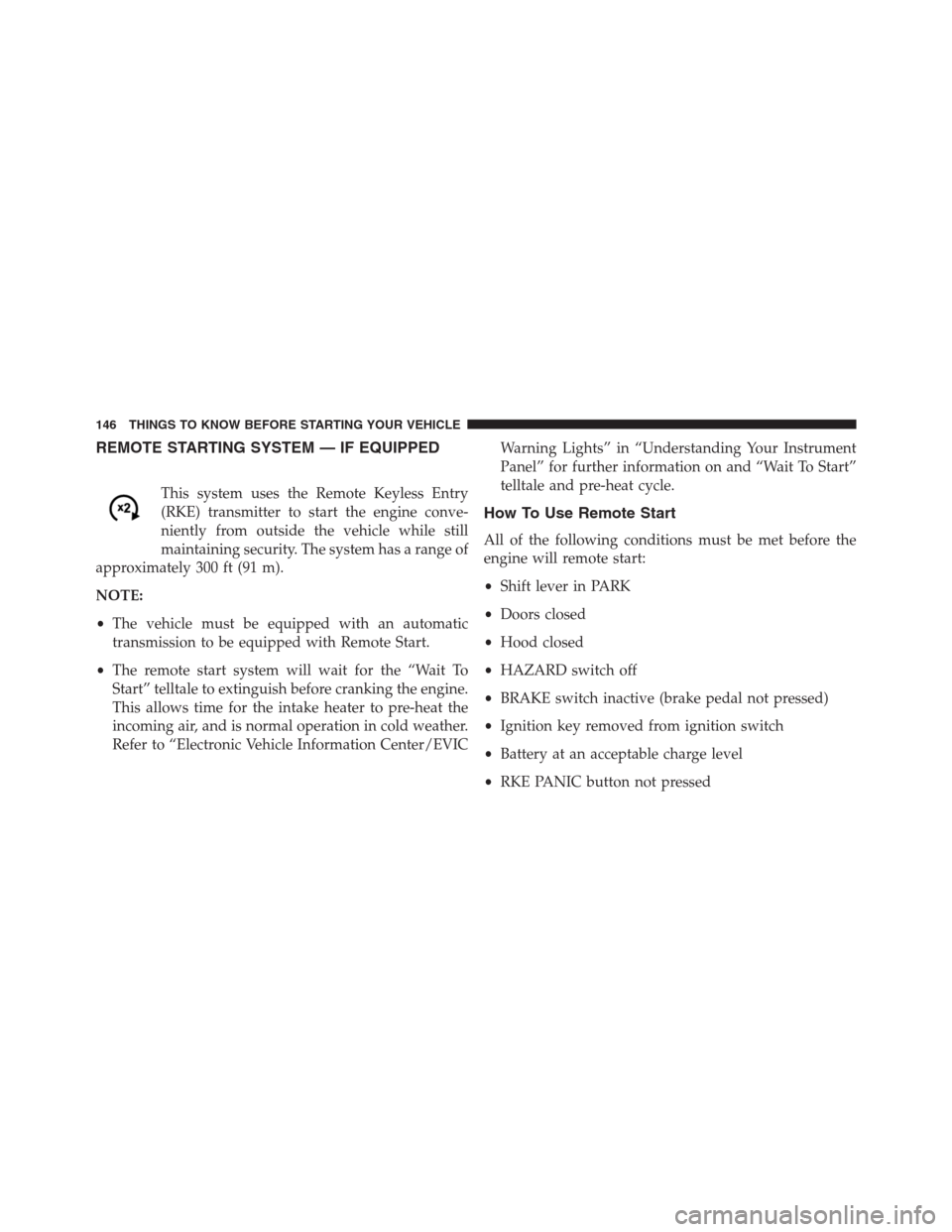
REMOTE STARTING SYSTEM Рђћ IF EQUIPPED
This system uses the Remote Keyless Entry
(RKE) transmitter to start the engine conve-
niently from outside the vehicle while still
maintaining security. The system has a range of
approximately 300 ft (91 m).
NOTE:
РђбThe vehicle must be equipped with an automatic
transmission to be equipped with Remote Start.
РђбThe remote start system will wait for the РђюWait To
StartРђЮ telltale to extinguish before cranking the engine.
This allows time for the intake heater to pre-heat the
incoming air, and is normal operation in cold weather.
Refer to РђюElectronic Vehicle Information Center/EVICWarning LightsРђЮ in РђюUnderstanding Your Instrument
PanelРђЮ for further information on and РђюWait To StartРђЮ
telltale and pre-heat cycle.
How To Use Remote Start
All of the following conditions must be met before the
engine will remote start:
РђбShift lever in PARK
РђбDoors closed
РђбHood closed
РђбHAZARD switch off
РђбBRAKE switch inactive (brake pedal not pressed)
РђбIgnition key removed from ignition switch
РђбBattery at an acceptable charge level
РђбRKE PANIC button not pressed
146 THINGS TO KNOW BEFORE STARTING YOUR VEHICLE
Page 170 of 360

Рђб5 MPH Max Speed Service DEF System See Dealer
РђбCoolant Low
РђбEngine Power Reduced During Warmup
РђбEngine Power Reduced up to 30-sec During Warmup
РђбEngine Power Reduced up to 2-min During Warmup
РђбActive Airbox Service Required See Dealer
Vehicle Information (Customer Information
Features)
Vehicle Information Submenus
РђбBattery Voltage
Displays the actual battery voltage.
РђбFuel Filter Life
Displays the life of the fuel filter.РђбOil Pressure
Displays the actual oil pressure.
РђбOil Temperature
Displays the actual oil temperature.
РђбTrans Temperature
Displays the actual transmission sump temperature.
РђбCoolant Temp
Displays the actual coolant temperature.
РђбTire Pressure Monitor System
Displays the actual tire pressure.
РђбEngine Hours
Displays the actual engine hours.
Gauge Summary (Coolant Temp, Trans Temp, Oil Temp,
Oil Pressure)
168 UNDERSTANDING YOUR INSTRUMENT PANEL
Page 213 of 360
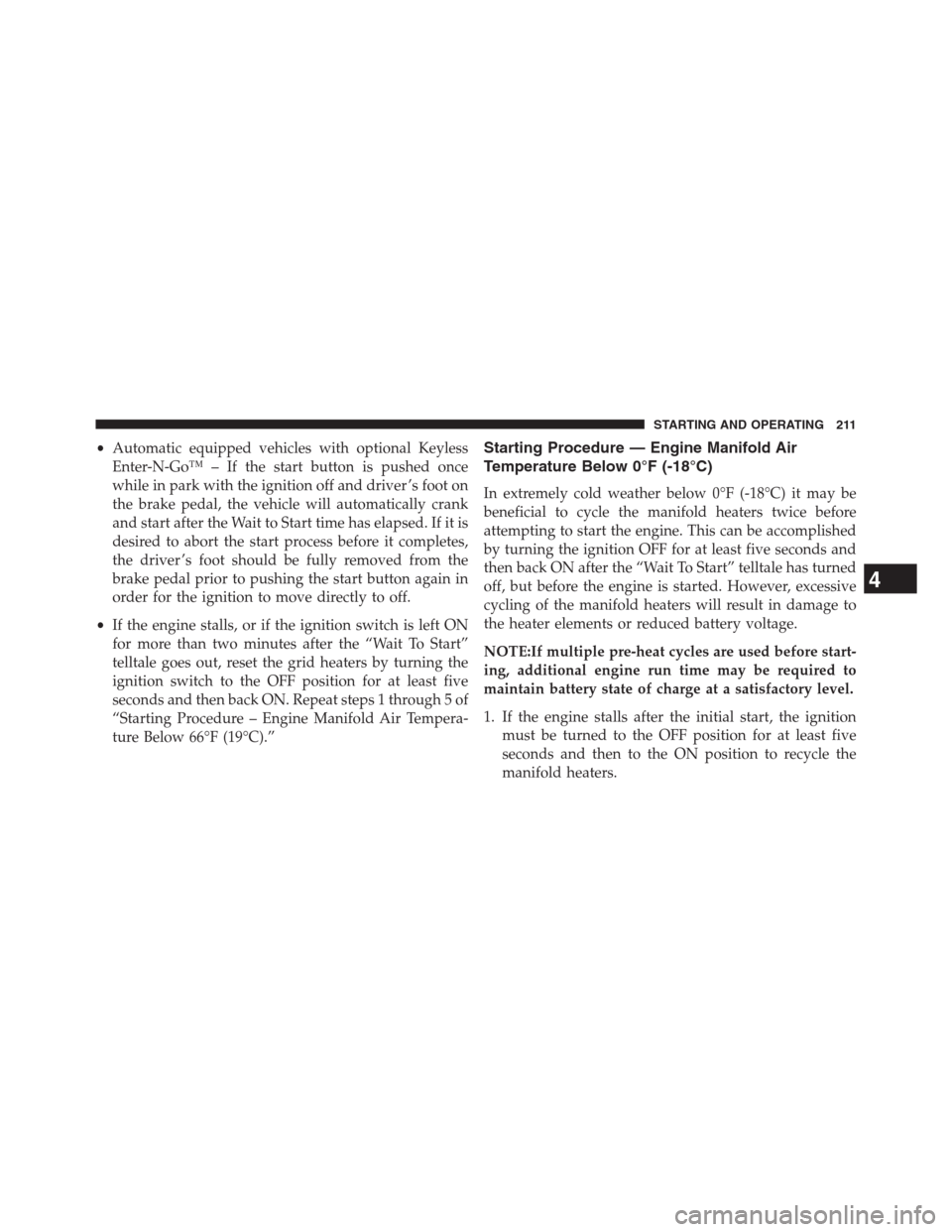
РђбAutomatic equipped vehicles with optional Keyless
Enter-N-GoРёб РђЊ If the start button is pushed once
while in park with the ignition off and driver РђЎs foot on
the brake pedal, the vehicle will automatically crank
and start after the Wait to Start time has elapsed. If it is
desired to abort the start process before it completes,
the driver РђЎs foot should be fully removed from the
brake pedal prior to pushing the start button again in
order for the ignition to move directly to off.
РђбIf the engine stalls, or if the ignition switch is left ON
for more than two minutes after the РђюWait To StartРђЮ
telltale goes out, reset the grid heaters by turning the
ignition switch to the OFF position for at least five
seconds and then back ON. Repeat steps 1 through 5 of
РђюStarting Procedure РђЊ Engine Manifold Air Tempera-
ture Below 66┬░F (19┬░C).РђЮStarting Procedure Рђћ Engine Manifold Air
Temperature Below 0┬░F (-18┬░C)
In extremely cold weather below 0┬░F (-18┬░C) it may be
beneficial to cycle the manifold heaters twice before
attempting to start the engine. This can be accomplished
by turning the ignition OFF for at least five seconds and
then back ON after the РђюWait To StartРђЮ telltale has turned
off, but before the engine is started. However, excessive
cycling of the manifold heaters will result in damage to
the heater elements or reduced battery voltage.
NOTE:If multiple pre-heat cycles are used before start-
ing, additional engine run time may be required to
maintain battery state of charge at a satisfactory level.
1. If the engine stalls after the initial start, the ignition
must be turned to the OFF position for at least five
seconds and then to the ON position to recycle the
manifold heaters.
4
STARTING AND OPERATING 211